This is a very long story that covers thousands of miles of coastline of Southern Mexico and El Salvador. We sail the coast with some good friends, do a lot of surfing, take an in-land trip to Oxacca with our pets and start to get our feet wet for the first time in Central America.
A Dream Come True
Our GPS has a little feature that keeps
track of the total distance traveled, like an odometer on a car.
Sitting here at the bottom of Mexico, I was surprised to notice that
during our 3 years in Mexico we traveled 4,000 miles. That's an
incredible distance considering the country is only about 2,000 miles
long and before this year we have mostly stuck to the northern half.

We had amazing experiences in
Mexico, ranging from surviving cancer to surviving hurricanes. You
might think those were bad things, but in the end the crises passed and
we were given a new lease on life and a fresh perspective.
We were happy to
consider ourselves residents of this country, as we had FM3's (resident
visas) and never
left Mexico once in two 1/2 years -- not even to buy boat parts. Yes Mexico was
good to us. Considering how overrun the country is with foreigners with
money, they manage to remain Mexican -- very warm, honest and happy
people. We wish the best for all the people we've gotten to know
along the way, and who have been there to support us through it all.
Our time spent in this
wonderful, beautiful place really was a dream come true, but now I'm
gushing. So, let's move on to our final leg out of Mexico. To
see the interactive satellite view of the above map of our anchorages
starting with Mazatlan
click here.
Hurricanes and 34 Cats Need Help
We had high hopes while Sherrell
recovered in Mazatlan from 5 surgeries and radiation treatment that
hurricanes would ignore us. After all we had enough going on,
right?
 Well, the weather disagreed.
Hurricane
Lane tried to thump us hard, but took a quick turn to the north and
missed us by 60 miles.
That was the closest
hurricane in 30 years. Lane brought
45-50 knots of wind and an amazing amount of rain which caused severe
flooding in some parts of town. But if that wasn't
enough we had
Tropical Storm (TS)
Miriam, Tropical Depression (TD) 2-C, TD 3-C, TS Norman, TS Olivia, TD
4-C and then Hurricane Paul. Paul was a biggie and built up fast. But
luck was with us as Paul fell apart rapidly before making land fall.
If you���?�re curious about Pacific Hurricanes, I���?�ve found a
good summary on Wikipedia.
Well, the weather disagreed.
Hurricane
Lane tried to thump us hard, but took a quick turn to the north and
missed us by 60 miles.
That was the closest
hurricane in 30 years. Lane brought
45-50 knots of wind and an amazing amount of rain which caused severe
flooding in some parts of town. But if that wasn't
enough we had
Tropical Storm (TS)
Miriam, Tropical Depression (TD) 2-C, TD 3-C, TS Norman, TS Olivia, TD
4-C and then Hurricane Paul. Paul was a biggie and built up fast. But
luck was with us as Paul fell apart rapidly before making land fall.
If you���?�re curious about Pacific Hurricanes, I���?�ve found a
good summary on Wikipedia.
While we
were keeping a "weather eye out" we took on a project of making pets
out of all the wild cats that have been set loose or wandered into the
marina. Their population was completely out of control. We
started trapping them in a humane trap from the volunteer animal
shelter, Amigos de los Animales (friends of the animals).
By the time we
were finished, we had rescued 34 cats (including kittens born from
captured pregnant cats).
 Most
were quickly adopted out to homes and about 4 were sterilized and
released back into the marina property. We picked the toughest
survivors who could fend for themselves and also didn't wander onto the
docks. Those 4 cats would act as a long-term barrier against other
cats settling into their territory. The other 27 were setup for
adoption and sterilization. Three cats ended up being adopted by
cruisers: Jordan (adopted by us, Sarana), Tripper (adopted by Ocean
Lady) and Captain Jack (adopted by Two Can Play).
Most
were quickly adopted out to homes and about 4 were sterilized and
released back into the marina property. We picked the toughest
survivors who could fend for themselves and also didn't wander onto the
docks. Those 4 cats would act as a long-term barrier against other
cats settling into their territory. The other 27 were setup for
adoption and sterilization. Three cats ended up being adopted by
cruisers: Jordan (adopted by us, Sarana), Tripper (adopted by Ocean
Lady) and Captain Jack (adopted by Two Can Play).
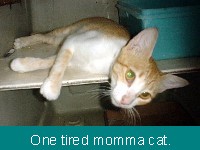 It's no easy
task catching wild cats. Often it was an all-night affair and we
had a lot of doubt about catching some of them, but patience paid off.
The last two kittens were tough. They even resorted to diving into
the water to escape us! I got a pretty good bite by one of those
buggers. By the time we caught those last two we were exhausted
and sleep-deprived.
It's no easy
task catching wild cats. Often it was an all-night affair and we
had a lot of doubt about catching some of them, but patience paid off.
The last two kittens were tough. They even resorted to diving into
the water to escape us! I got a pretty good bite by one of those
buggers. By the time we caught those last two we were exhausted
and sleep-deprived.
Fortunately some
of the other cruisers banded together to raise some money for us to help
cover all the costs for getting the cats sterilized and adopted.
It was a nice surprise to break even on the deal and get all those cats
care they needed.
There's a hurricane
coming, but look at this cool snorkel I found!
After our new crew member,
Jordan, settled in to living on our boat, we decided it was time to take
our furry feline to sea. So we dusted off the cobwebs, pulled out
the charts and departed Marina Mazatlan the first week in November.
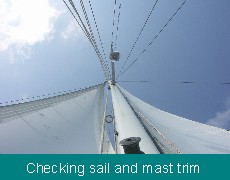 Our first stop was in
Matanchen Bay which is a great surfing spot if you can get there when
the southern swells are rolling in. And WHOO HOOO! they were
pumping. Even though I was tired, we unloaded the dinghy and the
engine and all my gear. Then fate stepped in and slapped me.
Our first stop was in
Matanchen Bay which is a great surfing spot if you can get there when
the southern swells are rolling in. And WHOO HOOO! they were
pumping. Even though I was tired, we unloaded the dinghy and the
engine and all my gear. Then fate stepped in and slapped me.
The outboard wouldn't even
pretend to start. Something happens when you live on a boat and
you're always taking care of stuff. There's some kind of unhealthy
emotional attachment that drives you to always keep things working.
So I became obsessed with getting the engine working again.
Despite warnings from Sherrell that I'd better take the surf while it
was there and just row the dinghy, I proceeded to tear down the engine.
As I was into my third try at
cleaning the carburetor the following day, the surf
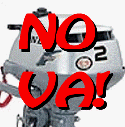 died.
Frustrated, I rowed my way over to the line-up, but it was way too
small. I realized I was a bit delusional about riding these little
waves when the fins on the surfboard bumped the bottom. The waves
were just too small to surf.
died.
Frustrated, I rowed my way over to the line-up, but it was way too
small. I realized I was a bit delusional about riding these little
waves when the fins on the surfboard bumped the bottom. The waves
were just too small to surf.
Dejected I rowed back and took
the engine apart again. Without much luck on the engine we headed
down south to
Punta de Mita
at the Northern edge of Bahia de Banderas (Puerto Vallarta). We hung out for several days all by
ourselves. It seemed there were no longer any cruising boats in
Mexico. There was an air of "Twilight Zone" but I had a motor to
fix. No time to worry about where the masses were.
A new spark plug (after 4
hours of bus travel and countless miles walked) didn't do anything even
though the spark looked good.
I knew it was the carburetor, but I didn't know why it didn't work.
I took everything apart, cleaned it with gas (for the 5th time) and the
motor wouldn't even give out a sputter for me.
We were listening to the daily
single-side band net when we heard there was a large depression that was
starting to rotate. This little bugger was to become Hurricane
Sergio, a rare November Hurricane.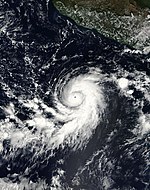
Great, just when our friends
were ready to catch up to us from Mazatlan this nasty appears -- Sergio. Well, Punta de Mita is no place to sit and wait for a
hurricane. It's exposed and we'd be ground into sand if Sergio
decided to show us a bad time.
While we were dinking around
with deciding what to do, Sherrell lost her clip-on sunglasses
overboard. In an instant they sank. She was almost in tears
because she takes meticulous care of them and they are impossible to
replace (and she also looks great with them on). Much to my
chagrin I donned my mask, snorkel, and fins and began the search.
The color of these sunglasses
blended into the sand. There were no reflections and no sign of
them. Wind blew our boat around and we were quickly loosing track
of the location where they were dropped overboard. Sherrell rigged
a float and dropped it in as a marker. I kept diving but I was a
bit congested and going down 25 feet repeatedly was beginning to be
painful.
Somewhere along the 20th
attempt I quit. Sherrell tried to remain stoic and said thanks for
trying, but I could see the disappointment. So I offered to go to
shore and track down a dive tank. Her eyes lit up and soon we
found ourselves at a surf shop that happed to have a half empty tank we
could rent for $10.
Down I went in the fading
sunlight. I criss-crossed the bottom in a wide search pattern, but
nothing. The half-empty tank only had about 1000 pounds in it, so
I breathed deeply and slowly trying to conserve the tiny bit of air.
I gave up the search pattern and began to check areas randomly to speed
things up. Suddenly I spotted a nice snorkel laying in the sand.
I happily snatched it up thinking at least we found something!
As my air ran low, I realized
I probably wasn't going to find the sunglasses and I surfaced. "I
couldn't find them, sorry. But I did find this cool snorkel, it's
just like mine." As I handed it up to her from the water I noticed
there was a name on it -- MY NAME! Sherrell said, "Great you found your
own snorkel. Good job." It had come loose while I was
searching the bottom. At least I didn't loose that too.
Despite our misadventures in
diving we were feeling a bit like we isolated in Punta de Mita.
There was no one there and the weather was a bit rough due to the wind
direction. So we sailed further into the
bay to
La Cruz. We found a few boats anchored there. One of
them, Effie, we knew from Mazatlan. Cool! We joked around
with them about all the wimpy boats we could hear on the radio who were hiding
in the marinas because of Sergio. (However we both made sure there
was still space for us if we had to hide too.)
We had a little pot-luck
amongst the 4 boats there and waited for Senior Sergio to do something.
Sergio spun around and around and wandered a bit drunkenly before
burning out and bringing us a surprise downpour. Phew! That
was a close call.
While in La Cruz, we bumped into
our friends on Endeavor who were staying in one of the marinas. I
mentioned my outboard problem and he proceeded to tell me cleaning it
with gas won't work. I needed some forced air and probably some
nasty chemical to scrub it. Effie had a compressor, and I
found a shop with a carb cleaner. After taking the engine apart
again, and cleaning every orifice with air and the chemicals, the engine started the first crank
and has been running great since...sheesh. I'm glad there were
other cruisers around to help me out!
With the demise of Sergio, our
friends were finally able to leave Mazatlan, so we sailed back to Punta de Mita
and waited for the parade to show up. Four boats slowly drifted
in: Ocean Lady, Willow, Tara, and Godspeed.
Everyone in the group are surfers, so we had a surf session in the
mediocre waves (the swells just weren't working for us) before ingesting a HUGE
Thanksgiving Day feast. There are also several musicians in the
group, so once the food settled, instruments were brought out, and we
listened to some wonderful jamming late into the night.
All good things must come to end, and we had a deadline
to meet. So
we had to cut the fun short to meet up with our visitor flying into Barra de
Navidad.
Thumped at sea but
ready to surf
Heading further south requires
going around Cabo Corrientes (Cape of Currents) which marks the southern
entrance to Bahia de Banderas. Corrientes is one
of those places everyone yaks about endlessly using terms like "Cape
Horn of Mexico". The massive mountains on the cape produces its
own weather and it's usually not nice. Our forecast was for 20 to 25
knots from the NW. That usually translates to a windy bumpy ride.
But we had a schedule to meet, only a few days until Sherrell's mom
arrived and we figured she probably wouldn't like it if we didn't show up.
What we got was a 22 hour
sleigh ride, rolling through the rough waves. With the double
reefed main and the reefed head sail we rocketed down the coast to
Chamela. We arrived in the morning and slept most of the day.
I couldn't pass up snorkeling but Sherrell wasn't game. The
visibility was about 15 feet and there was a bunch of fish. Good
ol' Chamela never lets me down, unlike the battery in my little
underwater camera -- sorry no photos.
So, with time getting
crunched, we left early in the morning for another passage to Barra.
We were able to sail some until the wind switched on the nose and we had
to keep moving so we burned some liquid wind.
Barra
de Navidad is at the top of our
list of cool anchorages in Mexico. The lagoon, while often tricky
to enter or exit provides 100% protection from the outside weather.
We can surf at the beach and the town has just about everything.
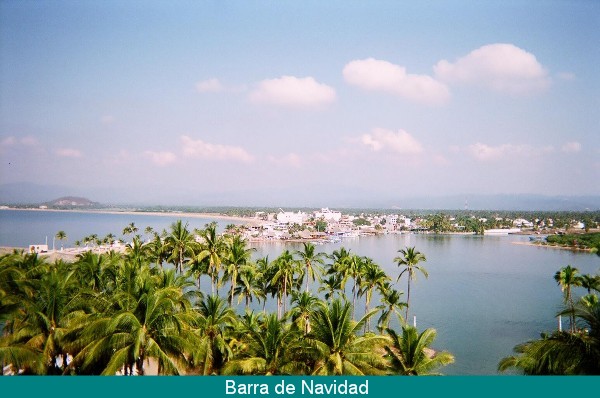
To top it off, we're anchored in the middle of a beautiful
placid lagoon and
there's a hotel that let's us use their pool. What more could you
want? French pastries delivered to your boat, you ask? Yes,
in fact, there's a French-Canadian who delivers his pastries right to
you every morning, if you have the funds for such things.
Sherrell's mom arrived safe
and sound (she's on the right in the photo) and looked forward to some warmth and
relaxation. It was only a couple days later before our sailing friends
caught up to us
from Punta de Mita. The swell finally showed up as well, so after
lots of waiting we could finally surf! We
(she's on the right in the photo) and looked forward to some warmth and
relaxation. It was only a couple days later before our sailing friends
caught up to us
from Punta de Mita. The swell finally showed up as well, so after
lots of waiting we could finally surf! We
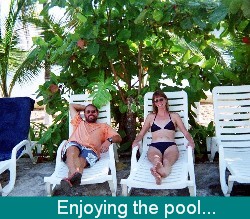 had a good time on the
beach, by the pool, and touring the lagoon. Sherrell's mom got to
see a different, more tropical part of Mexico (she last visited us on
Baja) and meet some of our friends. She
departed a little less pale, only to return to a record breaking Seattle
autumn storm.
Bummer.
had a good time on the
beach, by the pool, and touring the lagoon. Sherrell's mom got to
see a different, more tropical part of Mexico (she last visited us on
Baja) and meet some of our friends. She
departed a little less pale, only to return to a record breaking Seattle
autumn storm.
Bummer.
During her visit, Cassie, one
of Ocean Lady's dogs, passed away after some violent seizures. We
had the sad job of helping to organize a burial at sea late in the night.
It was very dark, so we called a water taxi (panga) to take us out of
the lagoon and into deep water. Under the dark sky
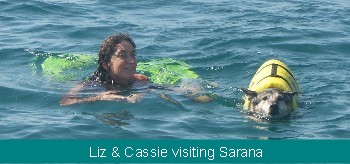 with
'Cassiopeia' overhead, for which she was named, we slipped Cassie overboard and said our goodbyes.
with
'Cassiopeia' overhead, for which she was named, we slipped Cassie overboard and said our goodbyes.
It took us quite awhile to get
over Cassie's death. We had spent so much time with her in Mexico,
that we had grown very attached. It was a real shock because she was such an
active pup, even for a 12 year old.
Picking Offshore
Coconuts
Shaking off the mood, we
planned to head to Zihuatanejo non-stop as soon as Sheila departed.
But then, Sherrell came down with a nasty cold. Willow and
Tara had left a few days earlier and Ocean Lady talked us into going 25 miles further to
Santiago
Bay and see how
Sherrell was feeling. Things were ok, but Sherrell really needed
more sleep, so Ocean Lady left in the early morning, and we decided to
leave in the afternoon and take our time.
It was brutal. There's
no other way to describe it. We both ended up with the cold and we
struggled hard to complete each of our watches. And that was just
the first night. By the second night, we thought we were going to
die. The wind was almost constantly on our nose and the seas were
sloppy.
So sloppy in fact the Mexican Navy
tried to board us, but couldn't because the seas were too rough.
Ok with me, but we wasted 2 hours trying to maneuver around and answer
their questions in Spanish by yelling across to their boat.
At times the wind seemed to
never want to stop blowing on our nose, it was driving us mad and we
were both bonkers from lack of sleep and the colds we were fighting.
Once, Sherrell woke me up in
the middle of the night to go
on watch (I had slept thru my alarm). I remember looking up at the d ark sky and seeing coconuts on
our mast (I was still inside the boat at this time). I told her in an
irritated tone, "No, I don't want to pick coconuts." and I went back to
sleep. A few minutes later she woke me up again and I found myself
sitting in the cockpit with the harness on and clipped into the boat.
I was looking around and I remember thinking, "I'm not picking coconuts,
I'm on watch!" That's how badly I needed sleep because of the
cold. Once the story got around, no one let me live that one down.
ark sky and seeing coconuts on
our mast (I was still inside the boat at this time). I told her in an
irritated tone, "No, I don't want to pick coconuts." and I went back to
sleep. A few minutes later she woke me up again and I found myself
sitting in the cockpit with the harness on and clipped into the boat.
I was looking around and I remember thinking, "I'm not picking coconuts,
I'm on watch!" That's how badly I needed sleep because of the
cold. Once the story got around, no one let me live that one down.
It is a bit scary how the lack
of sleep can really warp your brain's ability to function. After
that leg we swore to never do another passage if one of us is feeling at
all sick.
There was very little sailing
for us on this leg. Almost all 200 miles were covered using the
iron beast. Top that off with a cold, lack of sleep, the navy
attempting to board us, and picking coconuts and you get a sucky
passage.
Surfing, Partying,
and Free Diving for Stainless
We decided to settle into
Zihuatanejo for Christmas
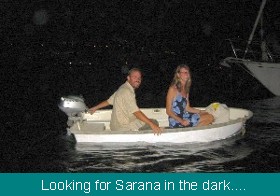 and New Years
with the whole gang. There's a pretty sizable tourist industry
complete with bars, restaurants, and a lot of water sports.
The bay is nice, but the jet skis, cruise ships, and parasailing speed boats
we could
do without.
and New Years
with the whole gang. There's a pretty sizable tourist industry
complete with bars, restaurants, and a lot of water sports.
The bay is nice, but the jet skis, cruise ships, and parasailing speed boats
we could
do without.
Z-town is usually as far south
as most of the Mexico-based cruisers go. It's a Mecca for
Sail-Fest, a fund raising event for schools that is driven by the
sailors
who come down to Zihuat. So we had a chance to meet lots
of new people, eat lots of cheap sopes ("so-payz") and drink $1 beers.
But, after a few days we were ready to get away from the busy town
activities.
We were itching for some surf,
so we sailed up to an island to the North of the bay where we could
anchor securely and only be a mile or so from the surf at Playa Linda.
The break was a classic beach break with peaks all up and down the
beach. The folks from Ocean Lady and Godspeed and I found our very own personal peaks
to surf and had a
blast! 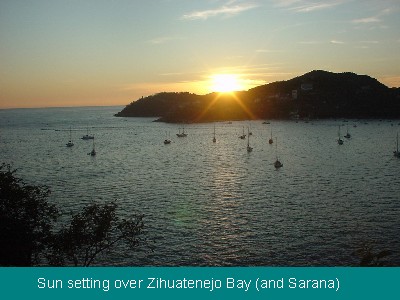 We talked
Tara and Willow into joining us and pretty soon
we had our own fleet out there surfing.
We talked
Tara and Willow into joining us and pretty soon
we had our own fleet out there surfing.
After a couple days, we
decided it was time to head back to town, but it was such a short
distance, there was plenty of time for 1 more surf session before
departing. Playa Linda was a pretty long
dingy ride for Willow, Tara and us with our tiny outboards,
so we
decided to just temporarily anchor the big boat in the roadstead off the beach and paddle into
the line-up. I got up early, all excited about surfing and started
to haul up the anchor.
We have a manual windless
which means when I want to pull up the chain I have this special
stainless steel handle that inserts into this device, then I pump it
back and forth and it slowly pulls up the chain. Well, we were
anchored in about 20 feet of water so there was really no force involved
in pumping up the anchor chain so I was cranking it up as fast as I
could. I watched two other boats already get their anchors up and
start motoring over to the beach. Not to be outdone, I cranked
faster.
Then suddenly I hit my hand on
something hard and I jerked it back in pain and I watched the handle fly
through the air in slow motion. It bounced off the lifelines then cartwheeled over the side of the boat with a splash. I yelled down to
Sherrell that I lost the handle over the side. She was none too
pleased.
Apparently I'm always dropping things over the side according to her.
So we broke out the snorkeling
gear and in the hazy light of dawn I went diving. At 20 feet down
on the bottom it was still pretty dark. After several attempts to
locate it by swimming along the bottom, I told Sherrell to call Tara to
borrow their scuba tank. I watched them do a U-turn and start to
head back, meanwhile the other boats left to get to the surf beach.
Not to be beaten by the stupid
stainless piece of pipe, I dove again looking for that handle. If
you've dove down to 20 feet before, you'll know that you don't have a
lot of breath for swimming along the bottom. So I kept making
multiple short dives while Tara crept closer. Suddenly I saw
something odd shaped -- the handle! I fought the urge to surface
and managed to grab it! I surfaced to Sherrell's cheer with the
stainless handle high in the air.
Ok, so now there's coconuts
and throwing my windless handle in the water. Fortunately the
waves were good and I quickly forgot about it. (I keep a slightly
tighter grip on it now.)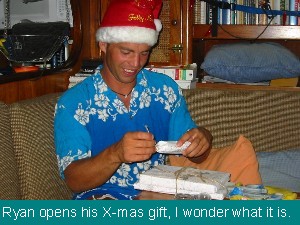
The surfing was great fun.
The waves were easy and everyone was getting good rides. Life
couldn't get much better. We went back to Zihuat for more grub,
Christmas and New Years Eve and started thinking about departing further
South.
In the meantime, Nicki on Tara
had a family emergency and had
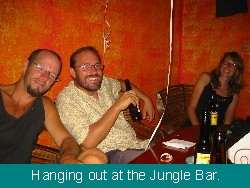 to return home
leaving Ben alone on the boat. And then Liz's dad
(Ocean Lady) passed away from an illness
that had slowly taken over his body and mind. His death was a
mixed blessing as he could no longer eat, talk, walk or even sit up, but it's
still always
sad to loose a parent.
to return home
leaving Ben alone on the boat. And then Liz's dad
(Ocean Lady) passed away from an illness
that had slowly taken over his body and mind. His death was a
mixed blessing as he could no longer eat, talk, walk or even sit up, but it's
still always
sad to loose a parent.
Our fleet was split. Two
boats had to stay to deal with family matters. Two other boats
weren't quite ready to leave (Godspeed and a new friend Get Lost) and
two of us were itching to go (Willow and Sarana).
After some late night bar talk, we decided to be the vanguard and find
some surf and report back to the others so they could join us.
Spanish Fortresses,
Uncharted Bays, and Surf Heaven
We left our friends and began the long leg down south.
Southern Mexico has proven to be a real challenge for sailing with
notoriously light winds. If
you're happy going less than 2 knots and drifting most of the time,
you'll do well here. So, we were ecstatic to be able to sail about 45
of the 110 miles to
Acapulco.
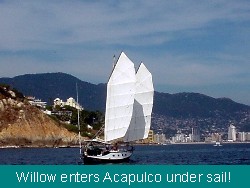
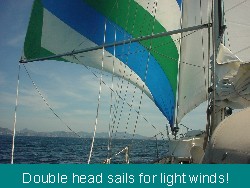
Deploying a double headsail with our drifter and the genoa created a massive amount of sail area. In the light, but
building winds from astern, we flew along under these two big sails. In grand
style Sarana and Willow sailed into the
 bay through
a narrow slot between an island
and some cliffs. Like the ships of old we opened a can of whoop-ass
and sailed all the way up to the anchorage.
bay through
a narrow slot between an island
and some cliffs. Like the ships of old we opened a can of whoop-ass
and sailed all the way up to the anchorage.
You don't even have to ask if we saw the famous cliff divers.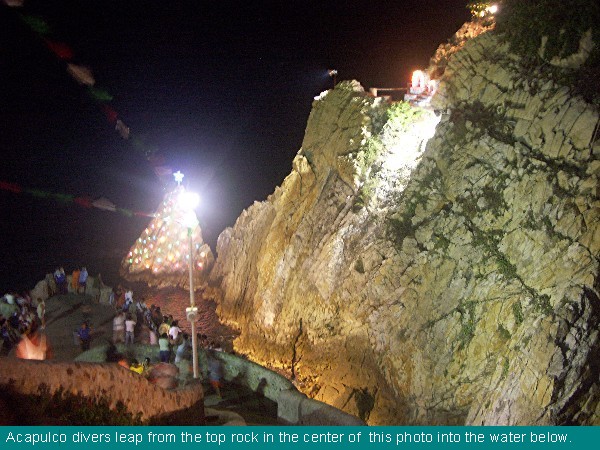
And we also toured the old Spanish fort built
to protect the city from pirates.
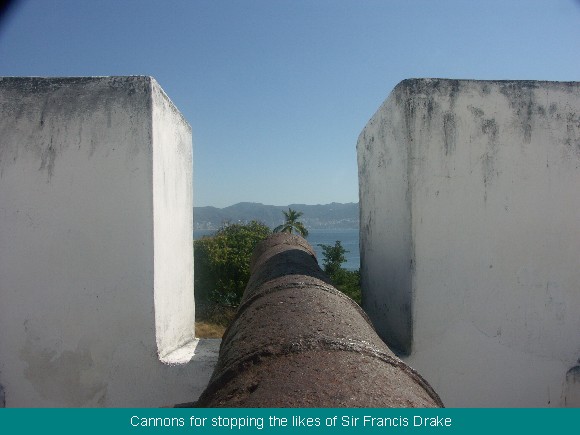
Named El Forte de San Diego and built between 1615 and
1617 (rebuilt again in 1776 due to an earthquake), this fort
helped Spain keep control of these waters until the Mexicans booted them
out. The fort has been converted into a cultural museum and historic center for learning about the pre-Hispanic and Hispanic people.
Archeological digs have indicated that people have inhabited this region
for over 3,000 years.
Like the Fort, Acapulco is a shell of what it once was.
The city is suffering from years of neglect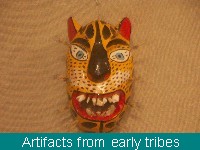 and
the appeal as a tourist
and
the appeal as a tourist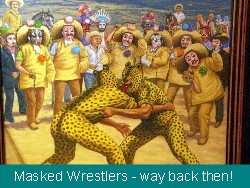 destination has faded. It's too bad because the place definitely
has some potential. The artwork and artifacts in the fort were
really cool and there's a strong sense of history in the city.
destination has faded. It's too bad because the place definitely
has some potential. The artwork and artifacts in the fort were
really cool and there's a strong sense of history in the city.
After a couple of days, we decided to haul up the
anchor, which was over 60 feet below us in the deep bay, and keep
moving.
We had spotted two very interesting things about this
next leg - There was a nice shaped bay on the chart which lacked any attention in the
cruising guides that seemed to have some anchoring potential. And,
more interestingly, a surf magazine had an advertisement with a tiny map
highlighting some areas with surf in Southern Mexico with one spot
somewhere along our route. The name of the surf spot was not
listed on our chart, however Sherrell's brain registered it as being
something she had seen before. She said, "Hey! I bet there's surf at
Punta Galera!" after realizing that the name on the surf map was
the same as a big lagoon behind this anchorage.
Either way we had to get moving and as usual the wind
was hiding somewhere from us. Throughout the day we couldn't get
much speed going, so we had to make a decision. The charts of
Mexican waters are so poor that you shouldn't ever try to make landfall
in the dark. Our only choices for making the P. Galera anchorage before dark
were to slow to 2.5 knots or speed up to 5.5 knots. Neither of those
ideas seemed attractive, So we decided to try a spot that Sherrell had
noticed on the charts called Bahia Dulce. The chart was pretty sketchy
and no guides had mentioned it, but we thought we'd tool around and see
if there was a place to anchor out of the swell.
We arrived at
Bahia Dulce
(Sweet Bay) at dawn and slowly crept into the uncharted bay.
We were treated to a very welcoming sight, with beautiful beaches and
calm peaceful waters. As we were motoring in, a Boobie bird landed on my head while I was
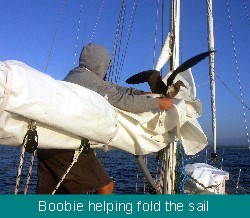 tying up the mainsail!
We were both equally shocked and he leapt to the mainsail and stood
there looking at me like I was guilty of messing up his perfect
landing. So he stayed with us for about 45 minutes and endured several
leaping attempts by Jordan. Ourselves and Willow found a spot in
about 35 feet and the holding was good. We went below and that's when the party started. It's
amazing how much crap one little bird can make. No problem, it just
washes off,
tying up the mainsail!
We were both equally shocked and he leapt to the mainsail and stood
there looking at me like I was guilty of messing up his perfect
landing. So he stayed with us for about 45 minutes and endured several
leaping attempts by Jordan. Ourselves and Willow found a spot in
about 35 feet and the holding was good. We went below and that's when the party started. It's
amazing how much crap one little bird can make. No problem, it just
washes off,
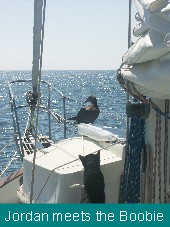 but it was funny watching Jordan stalk the bird because she
was a little afraid of the feathery monster that was as big as her.
but it was funny watching Jordan stalk the bird because she
was a little afraid of the feathery monster that was as big as her.
After eating and sleeping for about 5 hours, we decided
to press on and see if Sherrell was right about
Punta Galera.
Light winds again cursed us and we sailed about 20 miles
before it completely went away. So we motored for about 12 hours
to arrive in the bumpy anchorage of Punta Galera. It didn't take
more than a quick glance to see that we were in for some INCREDIBLE surf
(Greg in the foreground and Sarana in the background).
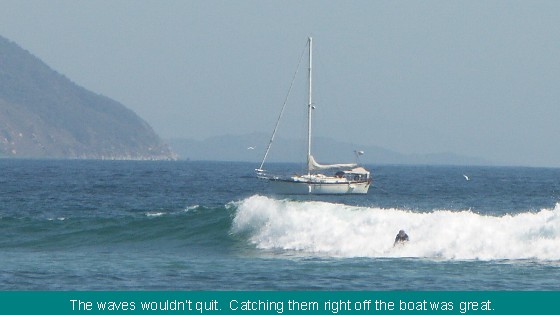
We stayed a couple of weeks. Long enough for
Tara, Godspeed, Get Lost and Ocean Lady to catch up to us and
see this incredible surf. The real bummer was after we hyped up
this awesome wave with tubes for a week, the day they arrived the swell died down!
Talk about bad luck.
It was still good enough to surf, so we kept going at
it.
 Get Lost
(see Panga to
Panama) was able to go up inside the lagoon (out of the rough
water) and anchored comfortably right off the tiny village. They got
mobbed when they pulled in. Everyone wanted to see these gringos
on the crazy super-panga. All the kids were touching it and pretty
soon they were playing soccer with them on the beach.
Get Lost
(see Panga to
Panama) was able to go up inside the lagoon (out of the rough
water) and anchored comfortably right off the tiny village. They got
mobbed when they pulled in. Everyone wanted to see these gringos
on the crazy super-panga. All the kids were touching it and pretty
soon they were playing soccer with them on the beach.
Meanwhile we planned a big meal and bonfire (fogata)
with a local beach restaurant and
the owner of the restaurant picked us all up so we wouldn't have to risk
the mouth of the lagoon in our small
dinghies in the dark (the surf line moves across the entrance).
On the beach we met other tourists who were vacationing
there. There was a group of kids from Mexico City who played
guitar and sung really well. My voice was hoarse the next day from
singing, but it was better than what my head felt like.

The lagoon has been made into a national park, and is
said to be the largest in Mexico. Reported to have a lot of wildlife inside the lagoon,
we
did a tour in our dinghies (braving the entrance with the 2HP -- not a
wise move). We saw lots of birds inside this massive lagoon that
runs about 20 miles along the coast.
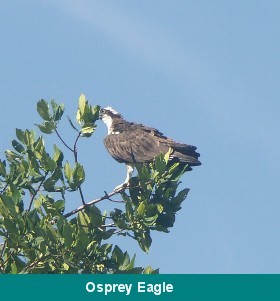

All of the boats had different things they wanted to do
and times they wanted to depart. Tara and Willow
were anxious to get down to Central America, so they departed one
afternoon when the
wind was really howling (a rare event). Godspeed decided to
go with them, since Ryan's parents were flying into Huatulco a few days
later. They were planning to go the
next day with us, but when it started blowing hard, they opted to take
the wind. After a crazy fire drill of getting up the stern anchors
in that wind then loading up the boats they took off. Two hours
later the wind was back to calm and they were motoring. We left
the following day and didn't have much luck either with the wind.
Since Ocean Lady and Get Lost had only arrived 4 or 5 days
earlier, they decided to stay and enjoy more of the "best surf" in
Mexico (Ocean Lady's words).
Sherrell and I decided to stop in
Puerto Escondito because it was a famous
surf spot and we thought it'd be cool to check out. There were
some great restaurants, but the swell was way to powerful for me to even
think about surfing (it's known as a board breaker). We hung out a couple of days enjoying the
scene and some good vegetarian food before we took off for Puerto Angel.
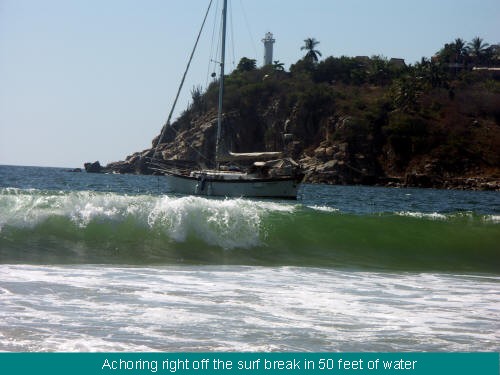
There was absolutely no wind again the day we left, so 37 miles
later we anchored in Puerto Angel without having even made an effort at
sailing. 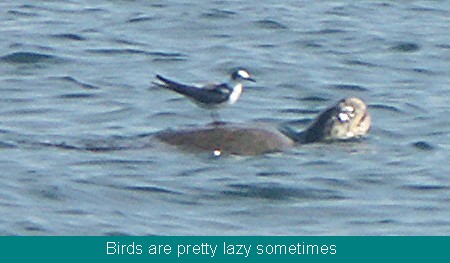 We did see lots of
turtles though. Actually thousands of
turtles. Turtles everywhere. So many turtles, in fact, that
even the dolphins were using them as toys and flinging them into the air
- I kid you not. We've all watched enough nature documentaries to
know that dolphins aren't always the sweet, cute, and gentle creatures
we'd like to believe, but it was still a gruesome shock to see this
behavior first hand.
We did see lots of
turtles though. Actually thousands of
turtles. Turtles everywhere. So many turtles, in fact, that
even the dolphins were using them as toys and flinging them into the air
- I kid you not. We've all watched enough nature documentaries to
know that dolphins aren't always the sweet, cute, and gentle creatures
we'd like to believe, but it was still a gruesome shock to see this
behavior first hand.
Gringos' Butts are Really White.
Puerto Angel ("AHN-hell") is barely a port. It's
pretty wide open but tucked far enough away from the coastline that most
of the waves don't find their way in. We arrived at about 5:30pm,
hot, tired and hungry. So while Sherrell started dinner, I decided
to shower. I set everything up and sat on the floor of the
cockpit. Life was good, the sun was setting, I was getting all
that salt off, when I had a funny feeling. One of those "I'm not alone" feelings. I peaked
out over the cockpit combing to see a panga full of armed Navy guys
coming right at us at full speed. I jumped up and dashed down
below just as they pulled up to us. I quickly dressed as I heard a
voices calling out their identity and informing us they were coming
aboard.
The port captain was with them and he was the first one
to scramble aboard and into our cockpit just as I climbed back up
wearing clothes. There was soapy water everywhere and my hair was
a wet mess. He didn't seem to register anything unusual, but the
Navy guys had changed their minds, and didn't want to do an
inspection after all. I wonder why, I thought.
The port captain was quick. He took our papers and
said we could pick them up in the office and then they all left en
masse. What can you do but laugh. I'm sure they went back
and told some stories about how white gringos butts are.
The Undiscovered Country
From Puerto Angel (remember that's "AHN-hell" not "AYN-gel")
we snuck around the corner to a series of bays, known collectively as
Bahias de Huatulco. Why snuck? Well, we had heard mixed
stories about what happens on this part of the coast that runs NE along
the Gulf of Tehuantepec. When the winds blow, and I mean BLOOOOOW,
in the Tehuantepec we didn't know what happens in Bahias de Huatulco.
We had heard a range of stories ranging from horror to
picnic. Not knowing what to believe, we probed Port Captains and
locals for more details. Most of them assumed we were talking
about the actual center of the Tehuantepec where it can be deadly.
So it was hard to communicate our questions because they don't sail and
they don't really know what type of information we're interested in.
So we snuck around the corner, wondering if 20 foot
waves with 8 second periods would trash us (as one sailor had warned
some friends). It was blowing pretty hard in the middle of the
Tehuantepec that day and sure enough we saw some weird waves. They
trucked along. Steep little suckers just ripping by at a speed
that seemed impossible. Fortunately they were only about 5-6 feet
and were about 5 seconds apart. It was very uncomfortable but
manageable and we actually managed to have a nice downwind sail for most
of the day, before finding a gorgeous anchorage protected from the
waves.
From our own ensuing experiences we learned that this area is
pretty protected from the winds of the Tehuantepec, but a diminished
version of the large waves still truck on into the coast. Since
the Tehuantepec BLOOOOWS so hard from Jan. to April, we got used to the
occasional wacky waves and enjoyed the bays in spite of them.
We spent 6 weeks in these bays, so I'll just tell you
about our favorites running from SE to NW.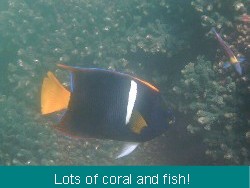
Jicarral had the best snorkeling. All these
underwater fish pictures were taken there. We had a few parties on
the beach with all our friends (minus Willow and Tara who moved on) and
we made some great memories there.
Chachaqual had a nice beach, some ok snorkeling and the
anchorage was a little rolly.
La India right next to Chachaqual is probably the best
anchorage.
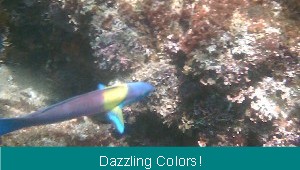 You have your own personal reef protecting you and a
very pretty beach to call your own.
You have your own personal reef protecting you and a
very pretty beach to call your own.
Cacaluta probably had the most interesting beach, but
the anchorage sucked as we had SW winds pounding us and rolling us the
whole time we were there.
Santa Cruz is the best place to anchor for provisions.
You can dinghy to the Pemex fuel dock for ice, water, and fuel or you can take your
dinghy into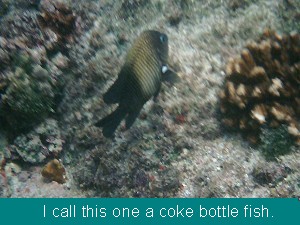 the darsena (public docks) where you can leave it
while you go into Crucecita (the main town) for supplies.
Ironically there is no actual town called Huatulco. Huatulco is an
Indian
word that means a view of the trees.
the darsena (public docks) where you can leave it
while you go into Crucecita (the main town) for supplies.
Ironically there is no actual town called Huatulco. Huatulco is an
Indian
word that means a view of the trees.
Marina Chahue ("CHAH-way") has all the bells and
whistles, but you have a long walk or a taxi ride just to get to a
store. There's an undeveloped section of Marina Chahue off to the
right as you enter. If you tie up on one of those unused docks (no
power or water) you only pay 1/3 the price. We spent two hours
sounding most of the channel in our dinghy before going in there so we
can say with some confidence that the first half of the channel gets no
shallower than 6 feet at low tide, and
the first set of docks has 10 feet of water, while the next several
docks have 5 - 6 feet. The docks on the left-side of the channel
have only 4 - 4.5 ft of water.
It was very quiet and we had a big 100 foot dock to ourselves.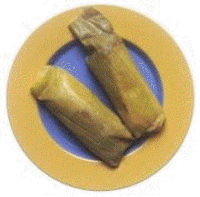
Downtown in Crucecita we found some great restaurants
ranging from Vietnamese Salad rolls to pizza. On the street
corners you could buy AMAZING tamales de elote (corn tamales) at about 3
for $1. Oh, how I love those things! MMMMMMM...tamales
de elote.
4 Cats and a Dog Go Driving
After Godspeed left for C. America, we decided to take a side trip to Oaxaca ("WHA-ha-ka")
with Scott & Liz from Ocean Lady to see some of the oldest ruins in Mexico. Getting
there with our personal zoo required some planning. After lots of
questioning, we decided just getting two small rental cars was the way
to go. We contacted a bunch of vacation rentals who stated they
were "pet friendly", but only one had availability. The owner of
this one (who was American) said, "Sure, bring your pets. [Pause] How many do you have?"
When we said quickly, "just a dog and uh... 4 cats." He
didn't even break his stride and said, "No problem."
So we loaded up and took off through the mountains.
We climbed up and up, turning through switchbacks every 100 feet or so.
In fact we probably drove twice as far as we needed to just because of
all the turns. My arms were sore 8 hours later when we arrived in
the city of Oaxaca.
Scott and Liz in the lead car managed to find "CASA RAAB"
in the dark and unlit rural area outside of town while getting
directions over the cellphone. To this day I'm
still not sure how
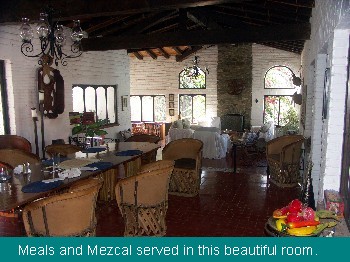 they did it. And
they did it. And
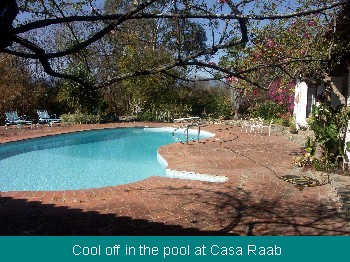 Casa Raab turned out to be
PARADISE. We each had our own very large room with nice bathroom,
and free run of the entire house. They had a swimming pool, 40 acres of land, horses,
donkeys, cats, dogs, and even birds. Better yet, they grew their own Agave (a plant used for making Tequila
and Mezcal).
Casa Raab turned out to be
PARADISE. We each had our own very large room with nice bathroom,
and free run of the entire house. They had a swimming pool, 40 acres of land, horses,
donkeys, cats, dogs, and even birds. Better yet, they grew their own Agave (a plant used for making Tequila
and Mezcal).
As luck would have it, Tony, the proprietor, was unveiling
his
cooked agave for making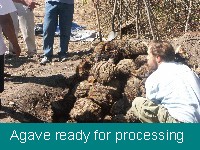 Mezcal the week we were there. The rare
event was a blast. They cook the hearts of the agave underground
in a pit and leave them for about 2 weeks.
Mezcal the week we were there. The rare
event was a blast. They cook the hearts of the agave underground
in a pit and leave them for about 2 weeks.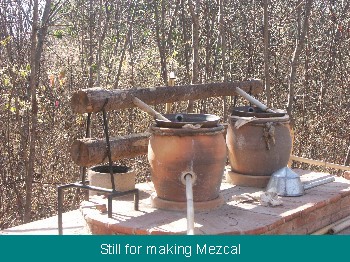
Then they mash up the pulp and put the juice in big oak
barrels for about a week or so while they ferment. Then they
distill it in a homemade still. Mezcal became a central feature
of our trip in Oaxaca.
We were so pooped from the long day of traveling, that
our first day was spent hanging out on the property and by the pool.
On day two, after feeling fully rested, we drove to
Monte Alban which has some of the most
spectacular ruins I've ever seen. Check out the 270 degree view
from the steps where we sat and pondered the immensity of the
structures and the culture.
The complexity of these structures, built around 500 AD
was staggering. Unfortunately most if not all of the significance
of these buildings has been lost in time.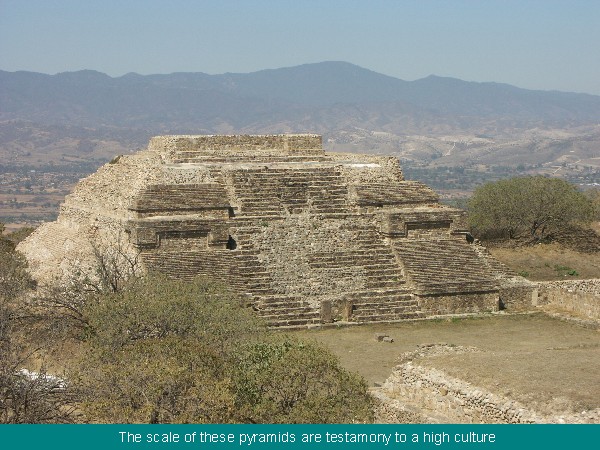
Of course they have some ideas, but even just recently
in Guatemala they discovered new paintings which threw a wrench into
their understanding of the Ulmecs and the Mayans. It's hard to
stand there and see all this knowing that there's no one around to
explain it anymore.
After spending a day hiking around ruins, we decided to
spend our next day in the city where we met up with our friend Mark
from Con Te Partiro. We toured the zocalo (town square) and
the cathedrals, after having a nice lunch. The old Spanish
architecture here is amazing - you really feel like you're in Europe.
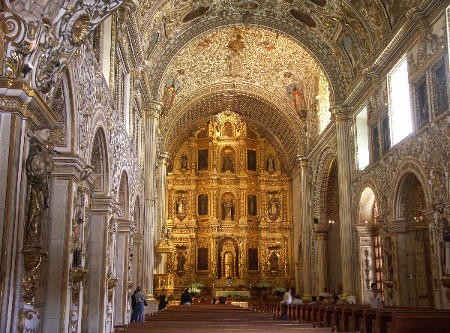
Very baroque, eh? It's the church of Santo Domingo
built in 1547.
And (upon my constant insistence) we took a trip to see
the worlds largest (in diameter) tree, called the
Arbol de Tule. It took nine photos stitched together to
bring this one image together so you could see the tree. Pretty
damn cool.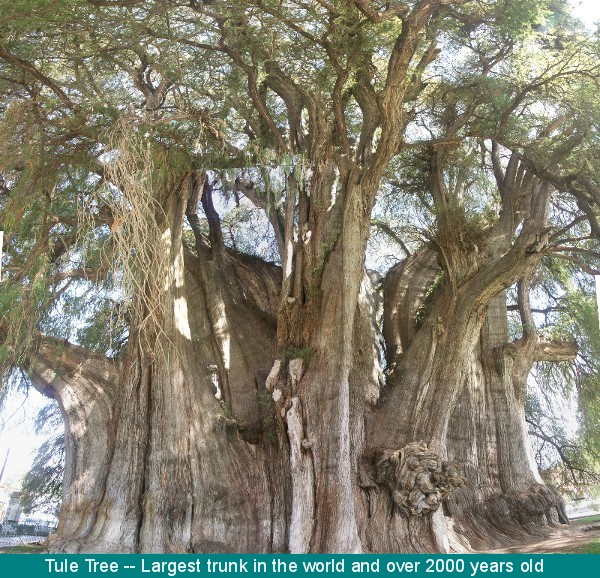
Then we went to see the Dianzu ruins. These were
less popular ruins and so they decided just to let tourists trample all
over them. Not being the superstitious types, we climbed into the
tomb chambers and had a look around.
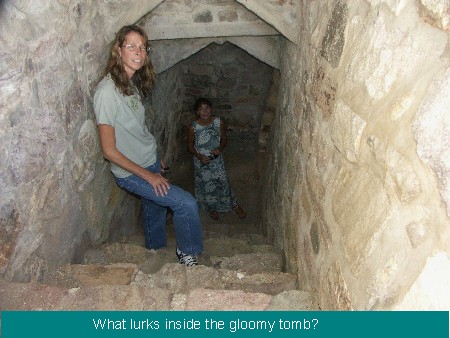
It was a bit like interactive archeology, but we were
careful not to do any damage.
Following the Dianzu ruins we went to see what was
happening at
Mitla
(built and active from 500BC to 200AD). Since the well publicized riots in Oaxaca had
scared off all the tourists, we basically had the place to ourselves.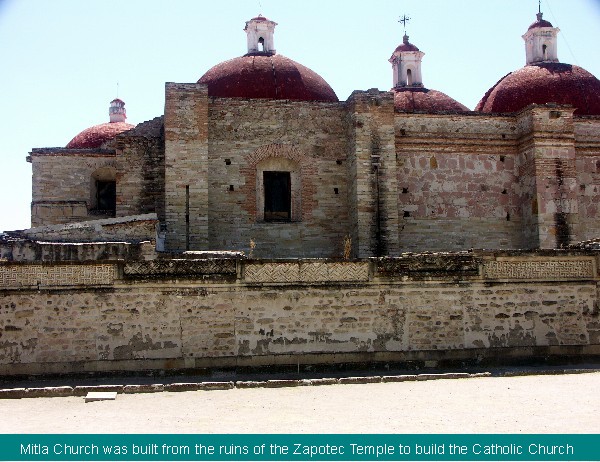
The architecture was unusual as they used columns. Not that I know much about these things, really, I read
that somewhere. I could see they spent a lot of labor in their
construction.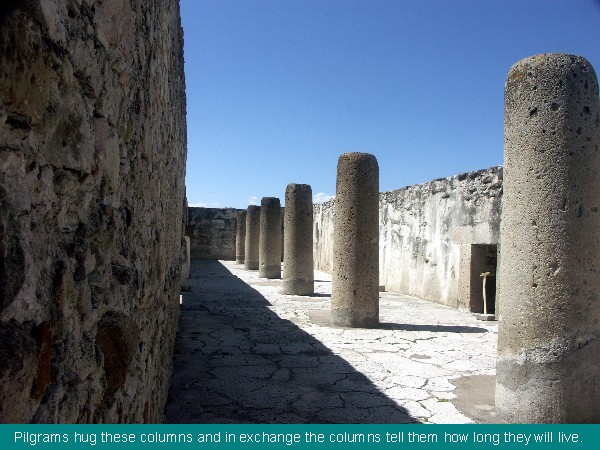
It was beautiful and dazzling.
Constructed in 500BC to 200AD these were some of the oldest buildings
still standing. The wooden roofs of course didn't stand a chance,
but a lot of the carvings and artwork survived. If you get a
chance, visit
 Oaxaca and tour it for yourself.
Oaxaca and tour it for yourself.
Oaxaca was a blast. We had Mark come join us at
Casa Raab for dinner a couple of times and we explored the intricacies
of Mezcal together. The animals had free range on the ranch and the
owners even took them on walks while we were gone! It will be hard
to top with our future land travel.
Hurricanes Again?
We took a different route back from Oaxaca, which went
through the town of Tehuantepec ("teh-wan-TEH-peck"). The Tehuantepec was doing it's
normal thing: BLOOOOWING (See
Tehuantepecker "teh-wan-TEH-pecker"). It was hard to keep the car on the road
at times. When we approached the shore from the hills the sea
looked white and we'd see massive balls of sand lifted off the beaches
and blowing out to sea.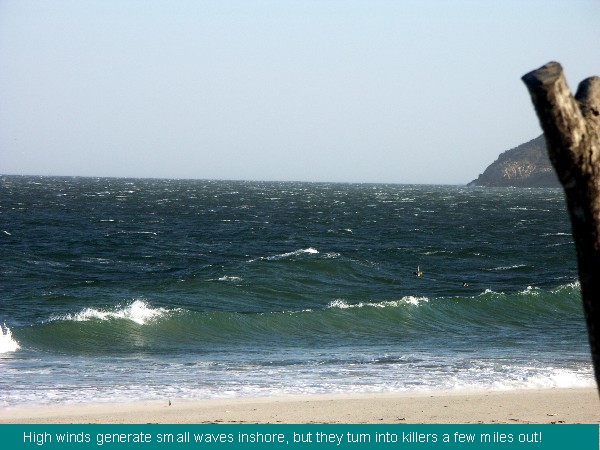
Later we learned it was only a Storm Force condition and
not quite at the hurricane force yet. We drove down to the beach
and saw first hand how it would SUCK to be caught in a Tehuantepec BLOOOW.
We returned to the Marina and went back to Jicarral and a
couple other bays to kill some time and wait for a weather window for
that stupid Tehuantepec.
Crossing the Tehuantapec
We stocked up and kept watching the weather. After
much discussion we saw what looked like a good 3 day window approaching.
Our plan was to go about 50 miles and anchor southwest of Salina Cruz (near
where we took pictures of the wind blowing) then cross the windy zone of
the Tehuantepec the next day.
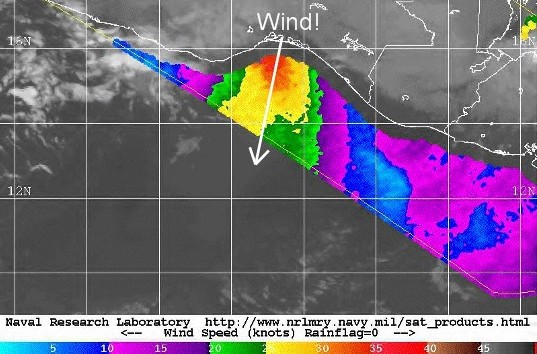
If we were able to sail enough, we could keep
going to El Salvador. However, with only 50 gallons of fuel, we
weren't sure we'd make the 545 miles without stopping somewhere.
There's never any wind when you need in this area, and you don't want to
drift around in the Tehuantepec waiting for it, that's for sure.
In a bit of a rush, we prepped the boat for heavy
weather and departed early in the morning. Often when there is
20-25 knots from the N in the Tehuantepec there's a wrap-around effect
along the coast which makes for a nice SE downwind sail to Salina Cruz.
We were counting on it for saving fuel. In fact during our 6 weeks
there it seemed to be the one local wind event that was predictable. Naturally there was no
wind when we set off, just a nasty adverse 1.5 to 2.0 knot current.
We motored the whole way and anchored for the night off
Punta Chipehua, where our guide book says, "Ships anchor here
sometimes, but there
is no protection." Great. Well the book was wrong.
There is no way a ship could anchor there with all the lobster pots the pangas put
out, but it was dead calm all night long.
Early in the morning we rose to face the "Gates of
Hell." We checked the weather forecasts which looked good, and threaded our way across
the shipping lanes of Salina Cruz and entered the shotgun barrel of the Tehuantepec.
We saw winds up to 16 knots from the SW and had some smooth sailing
in the morning.
That nasty current still dogged us though and again we ended up motoring most of
the time because the wind died. And like I mentioned earlier no one wants to sit around
in this part of the world and wait for it.
All along the coast we dodged shrimpers and pangas.
It kept us busy at night and due to the all the motoring, we were forced
to stop in
Puerto Madero for fuel,
which is the last port in Mexico.
Madero was alright. The Navy was a bit aggressive
in their need to search us upon arrival and departure (including the
drug dog). Also we had to pay API $7 just to anchor for the night. But we
got our fuel and some sleep and got out of there for the coast of
Guatemala. They plan on building a marina here in a year, so maybe
that will pave the way for easier entry and exit procedures for pleasure boats.
Upon leaving Madero we had a wonderful surprise:
wind and positive current! We blasted along the entire coast,
rarely under 6 knots, often at 7! It turns out we didn't need fuel
after all! After doing 3-4 knots all the way to Madero this was
undoubtedly nirvana.
It wasn't without it's troubles though. Sherrell had to
play dodge the pangas for several hours one night, as they were often
everywhere with only small lights. We learned a few days later that an experimental boat
from New Zealand doing an around the world trip using only biodiesel
collided with a panga, killing one fisherman and critically injuring another.
They hit that unfortunate panga in the same area we passed through 24 hours
earlier.
31 Foot Surfboard
We had been trying to catch up to Ryan (now known as
"Admiral" because he owns two boats thanks to a stranger giving him
his own boat in P. Madero) on his new boat Sonrisa. Our plan was to sail the coast with
him out of Madero, but he wasn't there and we hadn't heard from him.
So we continued on down the coast to El Salvador.
The current carried us the entire way! We were arriving 1/2 a day before I expected we would and that gave us two options. We
could either stop in Bahia del Sol or continue on to Barillas.
Bahia del Sol
is famous for the bar crossing at the entrance. Boats caught by
large waves have been broached and damaged trying to enter the estuary.
Barillas has a much easier entrance, with waves rarely breaking across
the channel.
As we approached Bahia del Sol we saw Sonrisa sitting
outside the entrance. Ryan had been waiting for 5 days because the
waves were too big to safely cross the sand bar. Once I saw him
anchored there, I thought, ok, we're going in here too.
We got word that the waves were a lot better and the bar
was going to be open at high tide around noon. There were 4 of us
waiting outside to go in, and two boats waiting to get out.
Around noon we got the word on the radio that the bar
was passable and Murray (the guy who guides people across the bar) was
coming out with our friend Chad (from Get Lost) to guide us all in.
A big catamaran that had been anchored outside with Ryan
for 5 days went in first. They somehow got
too close to the beach and within minutes surf pounded their
starboard ama sending spray up over their spreaders (about 30 feet in
the air). Then, a second wave hit them. At this point I stopped
pulling up the anchor and said to myself, they aren't going to make it
and there's no way in hell I'm going in there.
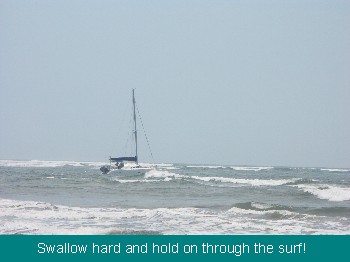 A third wave hit them. I could hear Chad on the
radio calling them over and over trying to get them to turn out to sea.
Fortunately the sets stopped and their reply indicated they were
confused about what was going on. But Chad got them back on track
and into the channel. So I started pulling up the anchor again,
thinking we'd better stay in that channel.
A third wave hit them. I could hear Chad on the
radio calling them over and over trying to get them to turn out to sea.
Fortunately the sets stopped and their reply indicated they were
confused about what was going on. But Chad got them back on track
and into the channel. So I started pulling up the anchor again,
thinking we'd better stay in that channel.
With the boat buttoned up (we even took off the solar
panel and our bimini) and us harnessed in, we approached the bar.
Following Chad and Murray's instructions and the lack of any rogue sets made the
crossing safe. We still did some surfing and there was lots of
waves that rolled us about 30 degrees to each side. But the breakers stayed outside of the
channel and life was good. Sherrell even said, "That was fun.
Let's do it again." At that point I looked closely at her to see
if she was really Sherrell.
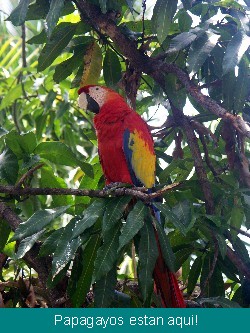 We
turned the corner, and spotted the marina with a few boats anchored
nearby. Once we had the anchor set, the navy came out for their
regular inspection and we checked into the country. We met up with Ryan,
Scott (also from Get Lost) and Chad at the bar and celebrated our exit from North America and
our glorious arrival in Central America!
We
turned the corner, and spotted the marina with a few boats anchored
nearby. Once we had the anchor set, the navy came out for their
regular inspection and we checked into the country. We met up with Ryan,
Scott (also from Get Lost) and Chad at the bar and celebrated our exit from North America and
our glorious arrival in Central America!
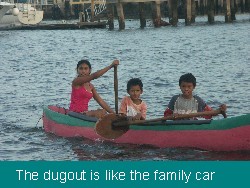
One of the best things about El Salvador are the PUPUSAS
("poo-poo-SUH"). They are like hearty corn tortillas stuffed with
goodies cooked inside. We get the bean ones, but they have shrimp, chicken, and
other combos. Here's a photo of some cooking on the grill -- YUM!
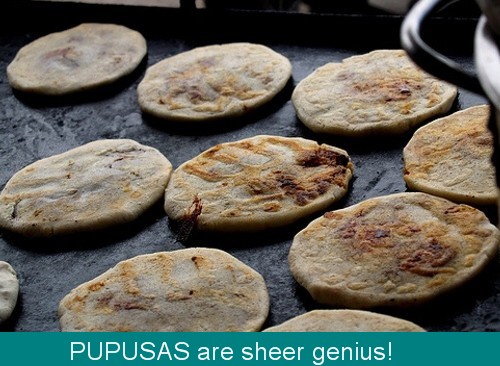
We did manage 3 side trips to San Salvador where the local markets were
booming away. The cost of living is a bit
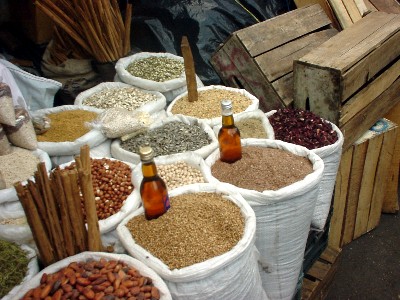 surprising,
though. It's quite high and one of the taxi drivers told me he
felt that not much has really changed since the '80's during the war.
I pointed out there seems to be a lot more work and less war. He
just sort of shrugged and said, more jobs yes but everything costs a lot
more too.
surprising,
though. It's quite high and one of the taxi drivers told me he
felt that not much has really changed since the '80's during the war.
I pointed out there seems to be a lot more work and less war. He
just sort of shrugged and said, more jobs yes but everything costs a lot
more too.
I have to say I've struggled to define El Salvador (if I may be so bold
to try). Th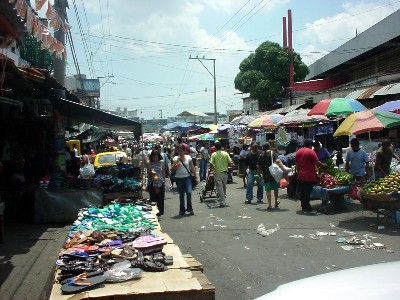 ere
is still a strong class division between the rich and the poor.
Where the rich are so very very rich they fly from place to place in
helicopters and the poor, well they have it tough. We could see
how the class wars fought in the '80's could again emerge. Many
people have a guarded edge to them, but they are still friendly once you
break the ice. Perhaps in some sense they still feel they are
fighting a little bit of the war. Maybe they are just shy of
foreigners, it's hard to say after only 4 weeks of exploration.
ere
is still a strong class division between the rich and the poor.
Where the rich are so very very rich they fly from place to place in
helicopters and the poor, well they have it tough. We could see
how the class wars fought in the '80's could again emerge. Many
people have a guarded edge to them, but they are still friendly once you
break the ice. Perhaps in some sense they still feel they are
fighting a little bit of the war. Maybe they are just shy of
foreigners, it's hard to say after only 4 weeks of exploration.
El Salvador is definitely an interesting place though and worth a visit.
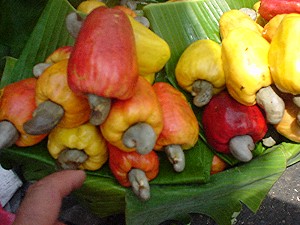 On
a personal note, I've made myself sick eating too many mangos and
pupusas. Oh and I learned why cashew nuts are so expensive.
Apparently the tree that bears them only produces one nut per fruit.
Check out the photo! That thing on the bottom of the fruit --
that's the cashew nut!
On
a personal note, I've made myself sick eating too many mangos and
pupusas. Oh and I learned why cashew nuts are so expensive.
Apparently the tree that bears them only produces one nut per fruit.
Check out the photo! That thing on the bottom of the fruit --
that's the cashew nut!
Well, we're pretty much loaded up and ready to check out some hidden surf
spots further East (that's right, El Salvador's coast runs West to East)
followed by Nicaragua. Now if the swell would just calm down enough
for us to get back out over the bar....
Related Slog Links: San Salvador | El Salvador -- Surf that boat! | Out of the T-Pec | So far so good. | Crossing the Tehuantapec | Our own dock | Nowhere to go but up. | Back on the Boat | In Oaxaca | Bahia Jicaral | Bahia Santa Cruz | La India | Updated slog with photos | Hard to bathe with the Navy Watching | Puerto Angel | Mexican Pipeline | A week into it. | Punta Galera | Bahia Dulce how sweet it is. | Underway | Sailing into Acapulco | Zihuat Madness | Trying to lift anchor | Arrived Zihuatanejo | In Santiago Bay | Cassie 1994 - 2006 | Barra | Visitors and Slog Readers | Barra Rocks | Chamela | Thanks Giving | Stopping Entropy | La Cruz de Huanaxtle | Punta de Mita | Chacala! | Casting off | Lots going on | The "done" list |



 died.
Frustrated, I rowed my way over to the line-up, but it was way too
small. I realized I was a bit delusional about riding these little
waves when the fins on the surfboard bumped the bottom. The waves
were just too small to surf.
died.
Frustrated, I rowed my way over to the line-up, but it was way too
small. I realized I was a bit delusional about riding these little
waves when the fins on the surfboard bumped the bottom. The waves
were just too small to surf.

 (she's on the right in the photo) and looked forward to some warmth and
relaxation. It was only a couple days later before our sailing friends
caught up to us
from Punta de Mita. The swell finally showed up as well, so after
lots of waiting we could finally surf! We
(she's on the right in the photo) and looked forward to some warmth and
relaxation. It was only a couple days later before our sailing friends
caught up to us
from Punta de Mita. The swell finally showed up as well, so after
lots of waiting we could finally surf! We
 had a good time on the
beach, by the pool, and touring the lagoon. Sherrell's mom got to
see a different, more tropical part of Mexico (she last visited us on
Baja) and meet some of our friends. She
departed a little less pale, only to return to a record breaking Seattle
autumn storm.
Bummer.
had a good time on the
beach, by the pool, and touring the lagoon. Sherrell's mom got to
see a different, more tropical part of Mexico (she last visited us on
Baja) and meet some of our friends. She
departed a little less pale, only to return to a record breaking Seattle
autumn storm.
Bummer. ark sky and seeing coconuts on
our mast (I was still inside the boat at this time). I told her in an
irritated tone, "No, I don't want to pick coconuts." and I went back to
sleep. A few minutes later she woke me up again and I found myself
sitting in the cockpit with the harness on and clipped into the boat.
I was looking around and I remember thinking, "I'm not picking coconuts,
I'm on watch!" That's how badly I needed sleep because of the
cold. Once the story got around, no one let me live that one down.
ark sky and seeing coconuts on
our mast (I was still inside the boat at this time). I told her in an
irritated tone, "No, I don't want to pick coconuts." and I went back to
sleep. A few minutes later she woke me up again and I found myself
sitting in the cockpit with the harness on and clipped into the boat.
I was looking around and I remember thinking, "I'm not picking coconuts,
I'm on watch!" That's how badly I needed sleep because of the
cold. Once the story got around, no one let me live that one down. and New Years
with the whole gang. There's a pretty sizable tourist industry
complete with bars, restaurants, and a lot of water sports.
The bay is nice, but the jet skis, cruise ships, and parasailing speed boats
we could
do without.
and New Years
with the whole gang. There's a pretty sizable tourist industry
complete with bars, restaurants, and a lot of water sports.
The bay is nice, but the jet skis, cruise ships, and parasailing speed boats
we could
do without. We talked
Tara and Willow into joining us and pretty soon
we had our own fleet out there surfing.
We talked
Tara and Willow into joining us and pretty soon
we had our own fleet out there surfing.
 to return home
leaving Ben alone on the boat. And then Liz's dad
(Ocean Lady) passed away from an illness
that had slowly taken over his body and mind. His death was a
mixed blessing as he could no longer eat, talk, walk or even sit up, but it's
still always
sad to loose a parent.
to return home
leaving Ben alone on the boat. And then Liz's dad
(Ocean Lady) passed away from an illness
that had slowly taken over his body and mind. His death was a
mixed blessing as he could no longer eat, talk, walk or even sit up, but it's
still always
sad to loose a parent. bay through
a narrow slot between an island
and some cliffs. Like the ships of old we opened a can of whoop-ass
and sailed all the way up to the anchorage.
bay through
a narrow slot between an island
and some cliffs. Like the ships of old we opened a can of whoop-ass
and sailed all the way up to the anchorage. Get Lost
(see
Get Lost
(see 


 You have your own personal reef protecting you and a
very pretty beach to call your own.
You have your own personal reef protecting you and a
very pretty beach to call your own.



 surprising,
though. It's quite high and one of the taxi drivers told me he
felt that not much has really changed since the '80's during the war.
I pointed out there seems to be a lot more work and less war. He
just sort of shrugged and said, more jobs yes but everything costs a lot
more too.
surprising,
though. It's quite high and one of the taxi drivers told me he
felt that not much has really changed since the '80's during the war.
I pointed out there seems to be a lot more work and less war. He
just sort of shrugged and said, more jobs yes but everything costs a lot
more too. ere
is still a strong class division between the rich and the poor.
Where the rich are so very very rich they fly from place to place in
helicopters and the poor, well they have it tough. We could see
how the class wars fought in the '80's could again emerge. Many
people have a guarded edge to them, but they are still friendly once you
break the ice. Perhaps in some sense they still feel they are
fighting a little bit of the war. Maybe they are just shy of
foreigners, it's hard to say after only 4 weeks of exploration.
ere
is still a strong class division between the rich and the poor.
Where the rich are so very very rich they fly from place to place in
helicopters and the poor, well they have it tough. We could see
how the class wars fought in the '80's could again emerge. Many
people have a guarded edge to them, but they are still friendly once you
break the ice. Perhaps in some sense they still feel they are
fighting a little bit of the war. Maybe they are just shy of
foreigners, it's hard to say after only 4 weeks of exploration.  On
a personal note, I've made myself sick eating too many mangos and
pupusas. Oh and I learned why cashew nuts are so expensive.
Apparently the tree that bears them only produces one nut per fruit.
Check out the photo! That thing on the bottom of the fruit --
that's the cashew nut!
On
a personal note, I've made myself sick eating too many mangos and
pupusas. Oh and I learned why cashew nuts are so expensive.
Apparently the tree that bears them only produces one nut per fruit.
Check out the photo! That thing on the bottom of the fruit --
that's the cashew nut!